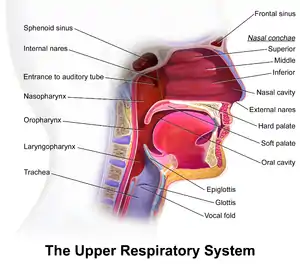Stertor
Stertor, from Latin 'stertere' to snore, and first used in 1804,[2] is a noisy breathing sound like snoring.[3][4] It is caused by partial obstruction of the upper airways, at the level of the pharynx and nasopharynx.[1][4][5]
| Stertor | |
|---|---|
 | |
| Stertor caused by partial obstruction of the upper airways, at the level of the pharynx and nasopharynx.[1] |
It is distinguished from stridor by its pitch.[4] Stertor is low-pitched, and can occur when breathing in, out or both.[1] Stertor and stridor can occur together, such as when adenotonsillar hypertrophy and laryngomalacia occur together.[1]
References
- Ida, Jonathan; Thomson, Dana Mara (2014). "Paediatric stridor". In Bower, Charles M. (ed.). Common ENT Disorders in Children, An Issue of Otolaryngologic Clinics of North America, E-Book. Elsevier. p. 798. ISBN 978-0-323-32622-3.
- "Definition of STERTOR". www.merriam-webster.com. Retrieved 10 January 2021.
- O Cathain E, Gaffey MM. Upper Airway Obstruction. In: StatPearls. StatPearls Publishing, Treasure Island (FL); 2020.
- Englar, Ryane E. (3 July 2019). "Stertor and Stridor". Common Clinical Presentations in Dogs and Cats. John Wiley & Sons, Ltd: 449–461. doi:10.1002/9781119414612.ch34. Retrieved 9 January 2021.
- Ayari-Khalfalla, Sonia; Froehlich, Patrick (2008). "21. Emergency management of the paediatric airway". In John M. Graham (ed.). Pediatric ENT. Glenis K. Scadding, Peter D. Bull. Springer. p. 185. ISBN 978-3-540-69930-9.
This article is issued from Wikipedia. The text is licensed under Creative Commons - Attribution - Sharealike. Additional terms may apply for the media files.